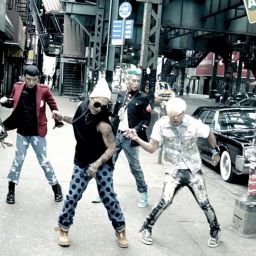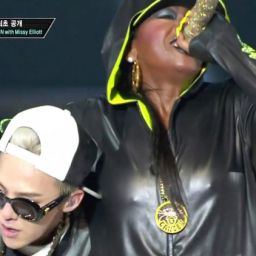by Miranda Ruth Larsen

While certain areas of Tokyo have become synonymous with different threads of popular culture, such as Harajuku for teen fashion and Akihabara for anime and video games, Shin-Okubo isn’t discussed outside of Japan very often. Yet the neighborhood sits on the infamous Yamanote train line that loops the very center of Tokyo, just one stop away from Shinjuku and a handful of stops from Shibuya, home to the infamous scramble crossing. Shin-Okubo is Tokyo’s Koreatown, and the streets are crammed with restaurants, cafes, beauty shops, and store after store of official and bootleg K-drama and K-pop goods. When the first iteration of the Korean Wave hit Japan, usually traced to the immense popularity of the drama Winter Sonata, Shin-Okubo became a central destination for fans looking to buy merchandise, eat Korean food, and network with other fans. That hasn’t changed, though Shin-Okubo has shrunk in size since then.
As the second iteration of the Korean Wave has shifted focus to mainly K-pop, the area remains a site of experiential fan pilgrimage and a place where we can see that “despite the inexorable process of globalization, national contexts – localized, linguistically, legally bounded systems – still matter in the production, circulation, and reception of media” (Galbraith, Karlin 12). Walking through Shin-Okubo is a visceral experience where one is suddenly plunged into the stylistic trappings of a Koreascape while being in the middle of Tokyo. It is one of the few places in Tokyo where Korean language often overtakes Japanese language on storefront signs and menus, and the neighborhood even boasts a few language schools for those interested in learning Korean.

Unlike Koreatowns found elsewhere, such as in Los Angeles in the United States, Shin-Okubo was from the beginning conceived as an enterprise of zainichi Koreans. ‘Zainichi’ refers to “those who came to Japan during Japan’s colonial rule over Korea and their descendants,” and the term is inextricably bound up with Japan’s colonial and wartime past as well as current issues of discrimination and immigration (Suzuki). Many of the businesses in the neighborhood are owned by zainichi but staffed by young employees more recently from Korea who are looking to improve their Japanese. Therefore, while the neighborhood may exist as part of a global Koreascape, it isn’t quite the same kind of ethnic community as other Koreatowns: the focus is on business rather than residence.
Shin-Okubo is also one of the cheapest places for foreigners to stay in Tokyo temporarily, with a number of hostels and hotels specifically catering to international travelers. This is especially handy considering the neighborhood’s central location on the Yamanote train line and the short walking distance to Shinjuku. Most importantly, Shin-Okubo remains a fan pilgrimage destination for people interested in K-pop, K-drama, K-beauty, and Korean food. Adding these influences together results in a neighborhood usually filled to capacity with a constant, but transient, flow of people.
[youtube_sc url=”CteoXaalB4Y”]
As discussed in my previous piece on Shin-Okubo for TLF , Japan is a vital part of the global K-pop machine for a variety of reasons and dependent on the labor of idols, staff, and fans in Tokyo. Shin-Okubo is home to a handful of performance venues where male rookie K-pop groups perform on a daily basis, with performance ‘seasons’ lasting from a few weeks to a few months. One of the main roads in Shin-Okubo is called Ikemen-Dori (literally “hot/good-looking guy road”) where these idol groups advertise their events by approaching passerby and offering them a printed flyer with their performance schedule. While these groups have their own original songs, CDs, and merchandise, for the most part they perform covers of K-pop, J-pop, and international artists.
My previous article outlined the industrial aims of Shin-Okubo, specifically the architecture of the concert and attached ‘benefits session’ where various interactions are codified and managed by the staff. This piece will shift focus to other affective interactions between idols and fans and, crucially, their labor. As Jungbong Choi contends, the culture of Korean Wave media “has been shaped and altered by fans themselves, who shoulder the role not just of information provider/mediator/distributor but also of cultural designer/administrator” (43). Nowhere provides better examples of this than the idol/fandom culture in Shin-Okubo.
For nearly two years I’ve conducted fieldwork in greater Tokyo and Shin-Okubo for my dissertation research focusing on Tokyo and male K-pop idol groups by attending concerts, conducting interviews, participating in benefits sessions, and accompanying idols as they conduct PR. While my research has included groups (and fans of groups) such as B.I.G., BIGFLO, HISTORY, and MAP6, my main fieldwork subject is CIRCUS CRAZY and their fandom.

When I first encountered CIRCUS CRAZY they were a five member group, but the current lineup features four: Kevin (leader), Daehan, Mingyu, and Kizo. A previous member, Dingo, left for creative reasons and Kizo recently announced he plans to enlist for his mandatory military service, required of all male citizens of South Korea. The other members, Kevin, Daehan, and Mingyu, are considered older by mainstream K-pop standards (in their late 20s and early 30s) and have already completed their military service.
Since Shin-Okubo venues are on the smaller side, and the structure of a concert includes benefits sessions and situations like demachi, fans and idols get to know each other on a different level of intimacy. Of course this is impacted greatly by factors such as personality, time and language skill (Kevin lived in LA and is fluent in English, for example). Nevertheless, the system provides a space for cultivating affect between fans and idols: to learn about each other, become familiar with certain habits, and so on. This is made obvious when new fans ask longstanding fans about an idol’s quirks, or when the idols are surprised to see a fan at an early afternoon concert because they know she usually works during the daytime.

A highly visible component of cultivating affect between the group members and fans are specialized penlights, sometimes referred to by K-pop fans as fan lights or lightsticks. Unlike the penlights brandishing both group logo and group color typical to K-pop, CIRCUS CRAZY penlights are emblazoned with the group’s logo but change color using a button. Each color is associated with a particular member. When the members perform solo songs everyone changes their penlight to that member’s assigned color, and now and then all the fans turn their penlights to white (especially during the last song of a performance season). However, the norm is to witness a sea of different colors, a tapestry of declared affective bonds.
The penlight system is also a useful way for fans to identify one another as a point of discussion and commonality. For example, I’ve occasionally been referred to as “the foreign girl in the front row with the green penlight” when newcomers don’t know my name. The multicolored penlight system is also a method for calculating popularity at a glance, checking to compare the numbers of each individual member’s fandom. When a fan changes their penlight color, which happens rarely, it is noticed and usually brought up in conversation after the concert as it indicates an important affective shift.
For the idols, the specialized penlight system makes finding particular fans in the crowd much easier. Though the penlights are turned off for ‘photo-time’ after the benefits session, sitting in the same seats means that the members recall the penlight colors from the concert to allocate their attention and poses for photos and video. In the same vein, the different colors are useful when fans are allowed to record or photograph during a song (all Japanese concerts are usually phone-free) and the idols desire high quality images of their performance. Nevertheless, when I interviewed him recently, Kevin (CIRCUS CRAZY’s leader), admitted that the moments when the fans record videos of the performances make him “kinda nervous.”
Kevin’s nervousness is well-placed, as fans usually create Instagram or Twitter accounts to post their photos and videos of Shin-Okubo idols, especially when the group welcomes fans to record PR. Since many fans own and are proficient with professional cameras, this is one of the most obvious arenas of fan labor. Oftentimes CIRCUS CRAZY’s photo-time session is filled with the sound of high-speed shutters clicking away as the group members wave and smile, and the images are uploaded later with pseudonymous watermarks. These images and videos circulate simultaneously as memory, evidence of co-presence, and promotion, and are often re-uploaded or liked by the idols themselves.

For special events fans use SNS to pool donations amongst each other for purchasing decorations, ordering flower stands, and printing specialized slogans. All of this is conducted without the knowledge of the idols and meant to surprise them, along with the venue staff and management company members. At CIRCUS CRAZY’s most recent Christmas concert, I was enlisted by other fans to hang up holiday banners and scatter balloons on the floor between the stage and the first row. After the concert we picked up and then popped all of the balloons to make a path to the stage’s stairs, otherwise the autograph and photo sessions would have required fans wading through the balloons. This kind of effort is considered small, of course, compared to what the idols go through.
K-pop idols in Shin-Okubo work extremely long days, including a morning rehearsal, an afternoon concert, the afternoon benefits session, PR, and then an evening rehearsal, evening concert, evening benefits session, and finally demachi. In many cases they are forced to quickly eat meals backstage while their hair is being styled and staff members are hurriedly pressing their clothes for the next event. Commonly the members share an evening meal with management late at night before preparing themselves to repeat the process over again the next day. This kind of schedule leaves little room for illness or mishap. Sometimes these back to back workdays are at the same venue – when they aren’t, that adds another layer of pressure to an already demanding lifestyle. “The [sound] engineer is very important,” Kevin explained when I asked about the challenges of performing at different venues, along with different “feelings” to the stage and atmosphere. Each venue presents different perks and challenges that the idols must navigate to create an experience with the fans.
When the idols get days off, the practical difficulties of living in Japan become more obvious. When asked about the hurdles of daily life in Japan aside from language, Kevin immediately pointed out that “the food in Japan is expensive” – one of the many reasons the idols are so grateful when fans give them food as gifts. In Japan the members live together in a dormitory provided by the management company. On their days off the Shin-Okubo venues are in use by other groups, which means any rehearsal has to happen elsewhere. Similar constraints exist even when the members are back in Korea: in CIRCUS CRAZY’s case, since the members live fairly far from each other, a two hour commute is required for group practice sessions. Oftentimes hitting that perfect note or nailing a bit of choreography has to be in a dormitory or done at home, on their own, instead of the high-gloss practice studios so commonly seen on YouTube.
In mainstream K-pop this amount of work is often rendered invisible, mentioned during interviews, or regulated to backstage content that is still carefully choreographed and approved before it airs or is uploaded. While certain platforms like the V app (which I previously wrote about for TLF ) are attempting to close the gap, it doesn’t equate to the feeling in Shin-Okubo. In many venues a thin wall is the only thing separating the performance space and the backstage area; fans can overhear last-minute vocal checks while the idols can overhear fan conversations.
The atmosphere is charged with effort and intimacy, each side simultaneously declaring: I am working hard for you and here for you.
Author’s note: I am deeply grateful to the idols, staff, and fans that have contributed to my research, as well as TLF for giving me a space to discuss my dissertation. I asked Kevin if he had a special message for anybody reading this article, and he said: “CIRCUS CRAZY really wants to perform in America… we understand that K-pop’s popularity in America means we have a bigger chance of getting to do that. Please look us up online, follow us, and wait for us.”
Works Cited
Choi, Jungbong. “Hallyu versus Hallyu-hwa: Cultural Phenomenon versus Institutional Campaign,” in Hallyu 2.0: The Korean Wave in the Age of Social Media, eds. Sangjoon Lee and Abe Mark Nornes. Ann Arbor: University of Michigan Press, 2015.
Galbraith, Patrick W. and Jason G. Karlin. “Introduction: At the Crossroads of Media Convergence in Japan,” in Media Convergence in Japan, eds. Patrick W. Galbraith and Jason G. Karlin. Tokyo: Kinema Club, 2016.
Suzuki, Kazuko. “Koreans in Japan (Zainichi Koreans) Teaching Materials,” Columbia University Online. <http://www.columbia.edu/cu/weai/exeas/resources/pdf/koreans-in-japan.pdf>







Loved this article so much! Over the past year my younger sister has gotten super into K-pop. To the point that she started begging me to watch videos with her because she wanted to have someone to talk to. At first, I started giving the scene my attention to support her and just be a good sister. But somewhere along the way I started to actually get invested in what I was seeing.
Personally, I’ve always been super active in fandom and have a passionate interest in celebrity, fan culture, and the dynamic between the two. But seeing as I’ve always been drawn to Western/English speaking media – I’m going through a bit of a culture shock in this new environment. I’m also wondering how big of a space older K-pop fans have in the fan world. I’m 29 and my sister is 20. So there’s a pretty big divide there and sometimes we see things a lot differently.
Anyways, I’ve read your other articles as well and I wanted to let you know I’m super appreciative of them. I’m learning a lot from just lurking in fannish spaces, but having pieces like this helps so much more because – context. If you have any recommendations of other blogs/writers/people to follow for more intellectual adult takes on K-pop, I’d be really appreciative of it. Thanks again for sharing your writing!! I’ll be reading what you share in the future as well!